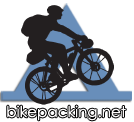 Show Posts Show Posts
|
|
Pages: 1 [2]
|
|
21
|
Forums / Ultra Racing / Re: Tour Divide 2013
|
on: January 12, 2013, 08:14:06 AM
|
|
Having ridden in 2012, this is what my future rig/kit will be until at least Steamboat:
On bike:
1. water cages/bottles x 3 (2,500 ml)
2. ground pad
3. frame bag
4. feed bag x 2
5. front bar dry bag
6. gps and narrative
Wear or store in frame bag:
1. shoes with wool socks x 2 plus gortex socks
2. glasses
3. helmet with rain cover
4. headband and balaclava
5. wool jersey (long sleeve) - 3 pockets in back
6. arm warmers
7. underwear
8. winter tights
9. wind vest - 2 pockets in front
10. rain jacket/gloves
Front bar/cockpit:
1. sleeping bag and quilt
2. feed bag x 2
3. iPhone (GPS) - SIM turned off
4. narrative (directions and resupply)
Left side frame bag:
1. passport, credit card, health insurance card, cash
2. flashlight (fits helmet)
3. spare AA batteries (flashlight and GPS)
4. pump, tools, scissors
5. bleach (drops bottle)
6. caffeine pills, nicotine gum, analgesic, alka-seltzer, 2 olive oil packets
7. neosporin, peroxide (drops bottle), sun screen (minimal through MT)
8. electrolyte pills -1 day's worth
Right frame bag:
1. unused riding clothes
2. extra food/water (only as needed)
3. inflatable ground pad
4. foam ground pad (on top tube)
5. tarp/bivy
6. narrative
7. battery charger, wall charger (one cord for both)
8. drive belt, 2 tubes, 100 ml sealant, 2 brake pads
cid:4C6A5498-CF3E-46ED-B57E-3B6AF5EB38F9/everything%2520carried.JPG
|
|
|
|
|
22
|
Forums / Ultra Racing / Re: Tour Divide 2013
|
on: January 11, 2013, 09:32:21 PM
|
|
Hi this is the 2012 rider Chris B. calls Mike#2. I loved riding with you Chris and everyone else I met along the way. Some wacky, fun times, for sure. Hardest thing I've ever done, mentally and physically. I loved every minute of it, though!!!
Made it to Lynxx Pass south of Steamboat in 18 days where a mechanical stopped me. I was mentally pretty well done, too, at that point. Fun reading the "getting ready for 2013" messages - here are my thoughts for folks.
Matthew, Scott, and the many GDR legends are beyond cool. Hope y'all get to know many of them. They have my utmost respect.
Live off the land. If you can't buy it at a gas station or scrounge it, you don't need it. If you can't eat or drink it, it's ballast.
It was way colder than I thought it would be. Dangerously cold. Be prepared to power/warm yourself 20 plus hours a day for 20 plus days. Unless you're an elite soldier or super human, it's almost impossible to train for or fully appreciate this. TDR is not just a bike race.
There are three good bike shops spread out along the route. Be prepared to buy new drive trains plus various bits at each. Then think about if you want to run high end set ups. Simplicity and constant mobility/progress is paramount.
If you like sleeping literally in the dirt and/or inside outhouses, this is you're event! Seriously, dont worry about technical details - the best bivy is the one that you know how to use, helps you recover, and fits in your bag.
TDR is vast almost beyond comprehension. Frankly it's dangerous. It will bend your mind and break you - every day. Veteran knowledge is a huge advantage. Be mindful, stay safe, and enjoy!
Politeness, gratuity, and respect for the land helps future riders.
|
|
|
|
|
23
|
Forums / Ultra Racing / Re: GPS question (would love Ollie W's opinion)
|
on: November 19, 2012, 08:19:29 PM
|
|
Good luck to everyone in 2013!
In 2012 my navigation/resupply/light/power strategy worked well for me and I'd do almost the same thing again:
- printed summary spreadsheet of water/supply/lodging options with distances
- printed detailed narrative edited down and tabularized
- AT&T iPhone 4 with Lifeproof case and the SIM lock feature enabled
- 2012 GPX file from Scott
- MotionX GPS iPhone app with predownloaded detailed topographic and road files
- backup of the two printed spreadsheets on the iPhone as Goodreader documents
- iPhone USB adapter/charger (the small adapter with the short cable)
- USB iPhone AA battery charger
- AA battery flashlight that fit my helmet
After testing lots of setups, I went this route because there was some navigation redundancy, it was rugged and easy to operate and power, and I was going to take the phone/charger anyway so why not fully use it.
Turned on the SIM only the few times I wanted to make a call or get SMS/email. Satellite strength was great
throughout and kept me right on route. The only exception was at the very top of Richmond Peak where I got pretty turned around. I cut a foam pad to fit the iPhone case and lashed it tightly to the stem. I charged up where I bought supplies, ate at restaurants, or slept at hotels. I followed the narrative and was frugal about turning on the screen to save power and, frankly, followed tire tracks quite a bit. Charging from AA batteries was my "reserve power" and did save me several times. The single AA flashlight was enough to get me down Fleecer Ridge to the paved road at Wise River in the pitch dark, but it really was not ideal for backcountry night riding.
The only thing I would do differently is use waterproof paper for the printed spreadsheets.
The downsides I experienced were:
- the batteries were expensive and, since I wasn't sure when i'd be able to get lithiums, I ended up carrying quite a few
- the time to lash and unlash the phone for charging inside a store/restaurant (or to take pictures)
|
|
|
|
|

